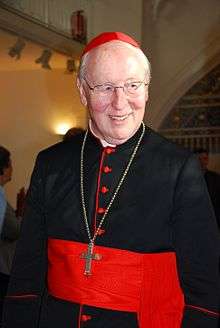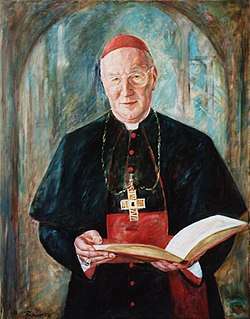Friedrich Wetter
| His Eminence Friedrich Wetter | |
|---|---|
| Cardinal, Archbishop Emeritus of Munich and Freising | |
 | |
| Church | Roman Catholic |
| See | Munich and Freising |
| Appointed | 28 October 1982 |
| Installed | 12 December 1982 |
| Term ended | 02 February 2007 |
| Predecessor | Joseph Ratzinger |
| Successor | Reinhard Marx |
| Other posts | Cardinal Priest of S. Stephano in Coelio Monte |
| Orders | |
| Ordination |
10 October 1953 by Clemente Micara |
| Consecration |
29 June 1968 by Isidor Markus Emanuel |
| Created cardinal |
25 May 1985 by John Paul II |
| Rank | Cardinal-Priest |
| Personal details | |
| Born |
20 February 1927 Landau (Rhineland-Palatinate), Germany |
| Nationality | German |
| Motto | Pax Vobis (Peace to you) |
| Coat of arms |
 |
| Styles of Friedrich Wetter | |
|---|---|
 | |
| Reference style | His Eminence |
| Spoken style | Your Eminence |
| Informal style | Cardinal |
| See | Munich and Freising (emeritus) |
Friedrich Wetter (born 20 February 1927) is a German cardinal of the Catholic Church. He was Archbishop of Munich and Freising, Germany, from 1982 to 2007. He was Bishop of Speyer from 1968 to 1982. Pope John Paul II made him a cardinal in 1985.
At age 91, Cardinal Wetter is the oldest living cardinal from Germany.
Early life and ordination
Born in Landau (Rhineland-Palatinate), Wetter studied in Landau and then, from 1948 to 1956, at the Sankt Georgen Graduate School of Philosophy and Theology and in the Gregorian University in Rome, where he obtained a doctorate in theology. In 1953, he was ordained a priest in Rome.
After being chaplain for two years (1956–1958) in Speyer, teaching in the seminary in the same city for another two years (1958–1960), and being assistant parish priest for a year in Glanmünchweiler, he became Professor of Fundamental Theology in Eichstätt for five years (1962–1967) and Professor of Dogmatic Theology at the Johannes Gutenberg University of Mainz in 1967, a post he held for only one year before being appointed bishop.[1]
Bishop
He was Bishop of Speyer (1968–1982) and became Archbishop of Munich and Freising in 1982.

Cardinal
He was made a Cardinal by Pope John Paul II in 1985, with the title of Cardinal-Priest of Santo Stefano Rotondo. He was one of the cardinal electors who participated in the 2005 papal conclave that selected Pope Benedict XVI.
Pope Benedict accepted his resignation on 2 February 2007.[2]
Views
Rights of Catholic politicians
Cardinal Wetter criticized in 2004 the Italian government's withdrawal of its nomination of Rocco Buttiglione to the European Commission.
Liturgical abuses
In an open letter in 2004, Wetter wrote that anonymous informers reporting liturgical abuses would labour in vain in the Archdiocese of Munich. "Blackening people's names, especially when the talebearer wishes to stay anonymous, will not get anyone anywhere in our archdiocese," Wetter warned. His comments followed the promulgation of the Vatican instruction on abuses in the liturgy, Redemptionis Sacramentum.
References
- ↑ Bavarian Radio Archived 24 June 2009 at the Wayback Machine.
- ↑ "Rinunce e Nomine, 02.02.2007" (Press release) (in Italian). Holy See Press Office. 2 February 2007. Retrieved 6 June 2018.
External links
- "Wetter Card. Friedrich". Holy See Press Office. Archived from the original on 4 September 2017. Retrieved 9 November 2017.
| Catholic Church titles | ||
|---|---|---|
| Preceded by Isidor Markus Emanuel |
Bishop of Speyer 1968–1982 |
Succeeded by Anton Schlembach |
| Preceded by Joseph Ratzinger |
Archbishop of Munich and Freising 1982–2007 |
Succeeded by Reinhard Marx |